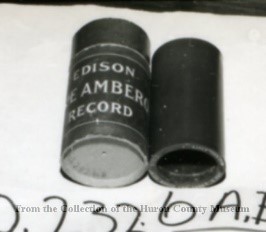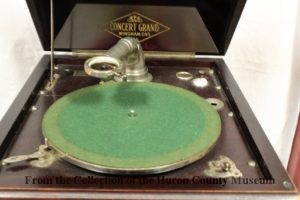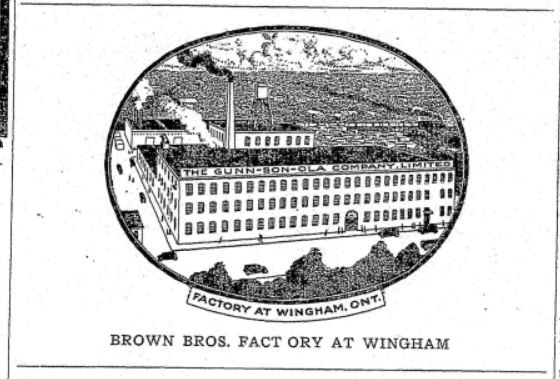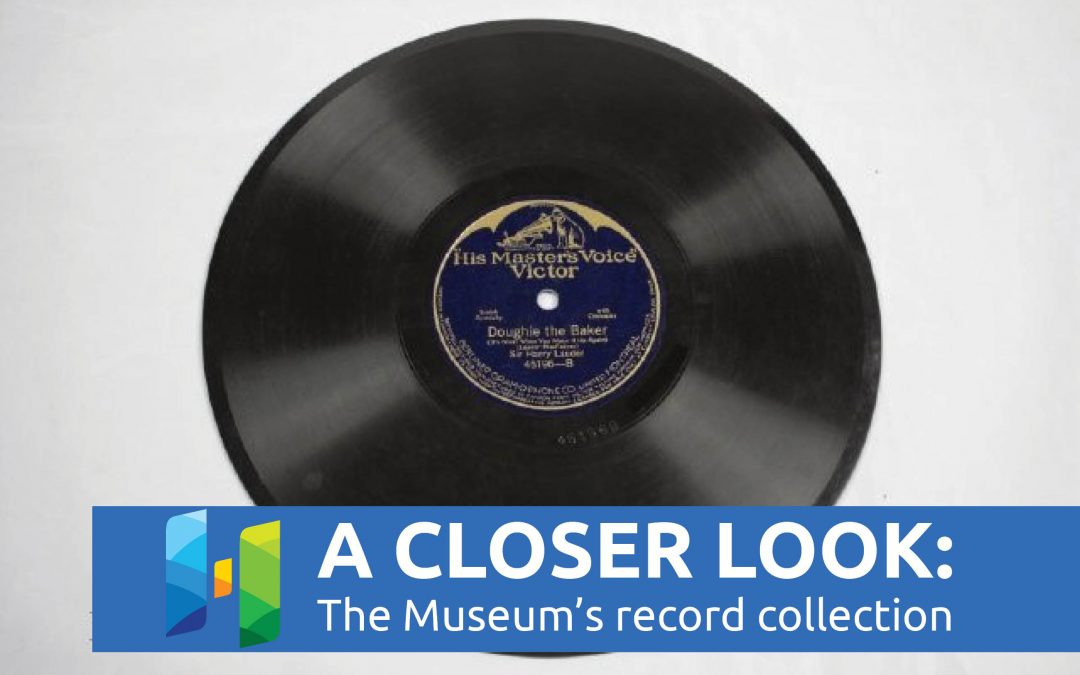Take a closer look at the Huron County Museum & Historic Gaol and its collections as staff share stories about some well-known and some not-so-well-known features, artifacts, and more. Acting Education and Programming Coordinator Dan Genis looks at the Museum’s record collection.

Record sleeve advertising the Victor Talking Machine Company of Canada Limited, featuring the slogan “Waiting to Sing to You.” Contains an early 1920s record by Harry Lauder. 2018.0026.002b
Did you know that Huron County Museum has a record collection?
While you might assume that record collections only belong to hardcore music fans or collectors, the Huron County Museum has an impressive record collection of its own. The museum collection contains almost 200 records, largely dating from 1900-1970. Music is a vital part of a community’s culture, which makes music-related artifacts important as well.

An Edison Blue Amberol phonograph record released in 1913. This 4 minute 17 second record plays “Alice Where Art Thou?” by Ernest Pike, originally composed by Joseph Ascher. M960.0232.006a
The collection begins with phonograph cylinders, commonly called “records”. Like the one in the above picture, the cylinders were meant to be played on a phonograph. Invented by Thomas Edison in 1877, early phonographs recorded sound as small grooves on a wax (later plastic) cylinder. To play the recording, the cylinder rotated and a stylus traced over the grooves and vibrated, reproducing the original sound. While in North America any sound-reproducing “talking” machine that uses records can be called a phonograph, in the United Kingdom (UK) the term more specifically refers to machines that play cylinders.
In 1889, Emile Berliner invented a phonograph that played discs records, calling it the “Gramophone.” Although disc records had been sold as early as 1889, it was not until the 1910s that they overtook phonograph cylinders as the record format of choice. Most disc records, including the “Harry Lauder” record in the picture above, were made with shellac. In the UK “Gramophone” became the term used to describe any disc-playing talking machine, but “phonograph” and “talking-machine” continued to be used in North America. This is especially confusing in Canada where all three terms had been and continue to be used interchangeably.

The “Concert Grand” talking machine (or gramophone), manufactured at the Gunn-Son-ola Talking Machine Co. in Wingham, Ontario. The gramophone was purchased by Lily and George McClenaghan and was always in their home at Whitechurch. 2018.0026.001a
The Gunn-Son-ola Talking Machine Company was founded in Wingham by Michigan manufacturer William Gunn in 1920. Gunn had purchased the Walker and Clegg furniture factory located on Alfred Street. Gun-son-ola churned out talking machines and cabinets for over ten years, at its peak employing 162 people. The company went bankrupt in 1931 and was taken over by Brown Bros. Manufacturing, which reverted the factory back into the manufacturing of general furniture products.
In the 1940s Polyvinyl chloride (PVC) began replacing shellac in the manufacturing of records. These new “vinyl” records were more flexible and less likely to break, which also allowed for smaller grooves (“microgrooves”) which could store more music.
By the time “The Best of Vera Lynn” was released in 1968, vinyl records were the most popular way of listening to recorded music. In the early 1980s cassette tapes had replaced vinyl in popularity, only to be itself replaced by the compact disk (CD) in the 1990s.There has been a vinyl record revival in recent years, with vinyl sales in 2020 surpassing CD sales in the US for the first time since 1986.
To check out more of the Huron County Museum’s record collection, head over to our online collections database at: https://huroncountymuseum.pastperfectonline.com/

A drawing of the Gunn-son-ola factory in Wingham, which primarily made talking-machines and radio cabinets. By 1935 it was owned by the Brown Bros. Company. The Wingham Advance Times 1935-05-16

